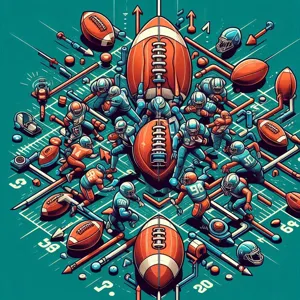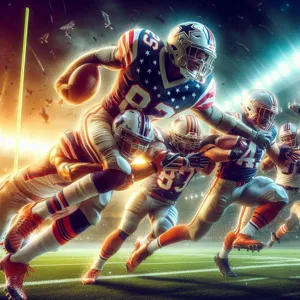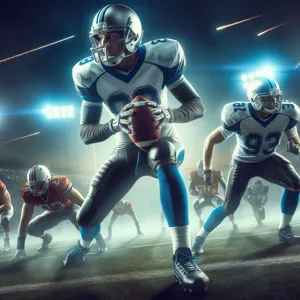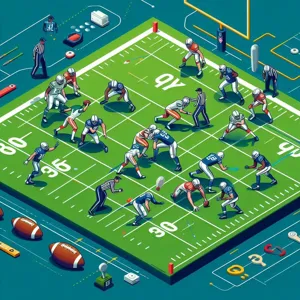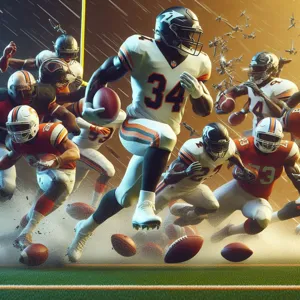In the high-stakes world of American football, where every play can define a season and every decision can alter a game’s outcome, the role of a coach transcends mere strategy; it becomes a pivotal force in unlocking the potential of athletes.
Coaches are not just instructors of technique; they are mentors, motivators, and visionaries who shape not only the skills but the mindset of their players. This blog post delves into innovative strategies that coaches can employ to inspire peak performance, fostering an environment where determination meets discipline and talent flourishes. From cultivating a winning culture to implementing effective communication techniques, we will explore actionable insights that empower coaches to elevate their teams, harness individual strengths, and ultimately achieve greatness on and off the field. Join us as we unlock the secrets to coaching excellence, setting the stage for a transformative journey toward peak performance in American football.
1. Understanding the Role of a Coach in Peak Performance

In the high-octane world of American football, the role of a coach transcends mere strategy and tactics; it is a multifaceted position that blends leadership, mentorship, and psychological acumen to drive athletes toward peak performance. Understanding this role is crucial for any coach aspiring to inspire their team to achieve greatness on and off the field.
At the core of a coach’s responsibilities lies the art of motivation. A great coach doesn’t just teach plays or formations—they ignite a passion within their players, instilling a belief that they can overcome obstacles and excel in the face of adversity. This involves creating an environment where athletes feel safe to express themselves and take risks, knowing that their coach is there to support and guide them. By fostering a culture of trust and open communication, coaches can unlock the inherent potential in each player, pushing them to levels they might not have believed possible.
Moreover, a coach must possess a keen understanding of the individual strengths and weaknesses of their athletes. This knowledge enables them to tailor training regimens that enhance performance while minimizing the risk of injury. It’s essential for a coach to recognize that every player is unique; what motivates one might not resonate with another. This personalized approach is pivotal in developing a cohesive unit that operates seamlessly on the field.
Another critical aspect of a coach’s role is their ability to strategize under pressure. During games, the dynamic nature of football requires quick thinking and adaptability. A successful coach must analyze opponents, make real-time adjustments, and inspire confidence in their players amidst the heat of competition. This ability not only impacts the outcome of games but also shapes the overall resilience and mental fortitude of the team.
Lastly, a coach serves as a role model, embodying the values of discipline, hard work, and sportsmanship. By demonstrating these principles, coaches instill a sense of accountability in their players, encouraging them to hold themselves and one another to high standards. This mentorship extends beyond the gridiron, shaping young athletes into leaders who carry these lessons into their personal and professional lives.
In essence, understanding the profound influence a coach has on the trajectory of their athletes is the first step toward unlocking the potential for peak performance in American football. By cultivating a holistic approach that balances motivation, individual development, strategic acumen, and exemplary leadership, coaches can inspire their teams to not only reach their highest potential but also create lasting impacts that echo far beyond the football field.
2. The Psychology of Performance: Motivating Athletes
Understanding the psychology of performance is a critical component in motivating athletes to reach their peak potential in American football. At its core, motivation is not just about instilling a sense of urgency to win; it’s about fostering a deep-rooted belief in individual and team capabilities. As a coach, your role extends beyond simply developing skills on the field; it involves cultivating a mindset that encourages resilience, focus, and a relentless pursuit of excellence.
Start by creating a positive environment where athletes feel valued and understood. Establishing strong relationships built on trust allows you to tailor your motivational strategies to each player’s unique personality and background. Some athletes thrive on competition, while others may respond better to collaboration and support. By recognizing these differences, you can effectively harness their intrinsic motivations, helping them connect their personal goals with team success.
Incorporate goal-setting techniques that empower athletes to set both short-term and long-term objectives. These goals should be specific, measurable, attainable, relevant, and time-bound (SMART). Encourage players to visualize their achievements, tapping into the power of mental imagery to enhance confidence and focus. Visualization can be a game-changer, allowing athletes to mentally rehearse plays and scenarios, ultimately reducing anxiety and boosting performance on game day.
Additionally, regular feedback is crucial in maintaining motivation. Constructive criticism, when delivered thoughtfully, can help athletes recognize areas for improvement while celebrating their progress. Celebrate small victories and milestones to keep morale high, reinforcing the idea that each step taken is part of a larger journey toward success.
Finally, instill a growth mindset in your players, emphasizing that failures and setbacks are merely opportunities for learning and growth. Encourage them to embrace challenges, persist through difficulties, and remain open to feedback. By fostering this mindset, you will not only motivate your athletes but also prepare them to navigate the pressures of competition with resilience and tenacity.
By focusing on the psychology of performance and harnessing these motivational strategies, coaches can inspire their athletes to unlock their full potential and achieve remarkable results on the field.
3. Setting Clear Goals: The Foundation for Success

Setting clear goals is the foundation for success in American football, serving as a critical blueprint for both coaches and players. When everyone on the team understands the specific objectives, it creates a shared vision that aligns efforts and drives motivation. Coaches must take the time to establish SMART goals—those that are Specific, Measurable, Achievable, Relevant, and Time-bound. This clarity not only enhances focus but also provides a framework for assessing progress and performance.
Imagine a team entering a season with vague aspirations like “getting better” or “winning more games.” Without clear targets, players can easily drift off course, unsure of what exactly they are working towards. In contrast, a well-defined goal, such as “improving our rushing yards per game by 20% by mid-season,” gives players a tangible metric to strive for. This specificity allows for detailed game plans and practice sessions that hone in on enhancing individual and collective skills.
Additionally, involving players in the goal-setting process fosters ownership and accountability. When athletes contribute to defining their objectives—whether that’s improving their tackling technique or increasing their fitness levels—they are more likely to stay committed to those goals. Coaches can facilitate this by holding one-on-one discussions, building a culture of collaboration, and encouraging open communication.
Regularly revisiting and adjusting these goals throughout the season keeps the momentum alive. This adaptability helps the team to celebrate small victories along the way, reinforcing progress and maintaining high morale. Whether it’s a mid-season review session or post-game analysis, these checkpoints not only track advancement but also cultivate a growth mindset among players.
By establishing clear, actionable goals, coaches set the stage for sustained success. Not only do these objectives guide training and performance, but they also instill a sense of purpose within the team. In the competitive world of American football, where every play counts, having a well-defined path can be the difference between mediocrity and peak performance.
4. Building Team Culture: Fostering Trust and Collaboration
### 4. Building Team Culture: Fostering Trust and Collaboration
In the high-stakes world of American football, success often hinges not just on individual talent, but on the strength of the team as a cohesive unit. Building a robust team culture is essential for fostering trust and collaboration among players, coaches, and support staff. This culture acts as the bedrock upon which peak performance is built, enabling athletes to push their limits and work seamlessly together on and off the field.
To cultivate this culture, it’s vital to prioritize open communication. Encourage players to express their ideas, concerns, and aspirations in a safe and supportive environment. Regular team meetings can create a platform for team members to share their thoughts, celebrate successes, and address challenges collectively. When players feel heard and valued, they’re more likely to invest in the team’s goals, leading to increased cohesion and a shared sense of purpose.
Moreover, establishing clear roles and expectations is crucial in fostering trust. Each player should understand their responsibilities and how they fit into the larger framework of the team. This clarity minimizes confusion and empowers individuals to take ownership of their contributions. As players step into their roles with confidence, they are more inclined to depend on one another, creating a ripple effect of collaboration that enhances overall performance.
Team-building activities, both on and off the field, can also significantly strengthen interpersonal relationships. Whether it’s engaging in challenging drills that require teamwork or organizing social events that allow players to connect outside of the rigors of practice, these experiences help build camaraderie. When athletes bond over shared experiences, they develop a greater sense of loyalty to one another, which translates into trust during high-pressure game situations.
Finally, celebrating both individual and team achievements fosters a culture of recognition and appreciation. Acknowledging hard work and dedication reinforces positive behaviors and motivates players to strive for excellence. Whether it’s through shout-outs during team meetings or awards for outstanding performances, recognizing effort creates an environment where players feel valued, inspiring them to elevate their game for the team’s success.
In conclusion, building a strong team culture rooted in trust and collaboration is a multi-faceted approach that requires commitment and intentionality from coaches and players alike. By prioritizing communication, defining roles, engaging in team-building activities, and celebrating successes, coaches can unlock the full potential of their players, driving them towards peak performance in American football.
5. Effective Communication: Techniques for Coaches

Effective communication is the cornerstone of successful coaching, especially in a high-stakes environment like American football. As a coach, your ability to convey strategies, motivate players, and foster team cohesion can significantly impact performance on the field. Here are several techniques to enhance your communication skills and inspire peak performance among your athletes.
**1. Clear and Concise Messaging**: In the midst of a fast-paced game, delivering clear and concise instructions is paramount. use simple language and direct commands that players can easily understand and execute. Avoid jargon unless you’re sure everyone is familiar with it. For instance, instead of saying, “Utilize the lateral play when transitioning from defense to offense,” simply say, “Move the ball sideways when we switch to offense.” This clarity helps players react quickly and confidently.
**2. Active Listening**: Communication is a two-way street. Encouraging players to express their thoughts and concerns fosters a culture of trust and respect. Practice active listening by giving your full attention when a player speaks, acknowledging their feelings, and providing feedback. This not only empowers athletes but also enables you to tailor your coaching strategies to meet their needs.
**3. Use of Visual Aids**: Incorporate visual aids such as whiteboards, play diagrams, and video analysis to reinforce your verbal instructions. Visual learning can be particularly beneficial in football, where complex strategies and formations are involved. By visually demonstrating plays, you help players better grasp their roles and responsibilities, leading to improved execution during games.
**4. Positive Reinforcement**: Celebrate successes, no matter how small. Recognizing efforts and achievements boosts morale and encourages players to continue striving for excellence. Whether it’s a simple “Great job!” after a well-executed play or a more formal acknowledgment during team meetings, positive reinforcement builds a supportive environment where players feel valued and motivated.
**5. Regular Check-Ins**: Establish a routine of one-on-one check-ins with players to discuss their progress, challenges, and personal goals. These conversations create an opportunity for in-depth communication and allow you to address any issues before they escalate. By showing genuine interest in their development, you not only enhance player-coach relationships but also promote a culture of accountability and growth.
By implementing these communication techniques, coaches can create a more cohesive and high-performing team. Effective communication goes beyond just relaying information; it builds trust, fosters collaboration, and inspires athletes to reach their full potential both on and off the field. As you work to unlock the potential of your players, remember that the way you communicate can be just as important as the strategies you employ.
6. Tailoring Coaching Styles to Individual Athletes
In the dynamic world of American football, one size does not fit all when it comes to coaching. Every athlete brings a unique set of skills, motivations, and challenges to the field, and as a coach, it’s your responsibility to adapt your coaching style to meet these individual needs. Tailoring your approach can significantly enhance performance, build trust, and foster a deeper connection between coach and player.
To begin with, take the time to understand each athlete’s personality. Some players thrive under direct, authoritative guidance, while others may respond better to a more collaborative and supportive approach. For instance, while a linebacker may excel with a coach who provides clear, structured feedback, a quarterback might flourish when encouraged to take the initiative and voice their strategies during practice.
Engaging in one-on-one conversations can also provide invaluable insights. Ask your players about their goals, their fears, and what motivates them on and off the field. This will not only help you to identify the best methods to inspire them but also demonstrate that you value their individual aspirations. By establishing this rapport, you create an environment where athletes feel empowered to express themselves, leading to increased confidence and improved performance.
In practice sessions, consider varying your methods to cater to different learning styles. Visual learners might benefit from video analysis of their gameplay, while kinesthetic learners may need hands-on demonstrations. Mixing up drills and incorporating gamified elements can keep sessions fresh and exciting, ensuring that all athletes remain engaged and motivated.
Ultimately, the goal of tailoring your coaching style is to unlock each athlete’s potential. By meeting them where they are, you can cultivate an atmosphere of trust and respect, allowing players to excel in their roles. As a result, not only will your team perform better on the field, but you’ll also foster a culture of growth and resilience that extends beyond the game itself—an invaluable lesson for life.
7. Incorporating Mental Training Techniques

In the high-stakes world of American football, physical prowess is only one piece of the puzzle; mental fortitude is equally essential for achieving peak performance. Incorporating mental training techniques into your coaching strategy can transform your players’ game-day experience, helping them to manage pressure, enhance focus, and maintain resilience in the face of adversity.
Begin by integrating visualization exercises into your training sessions. Encourage players to vividly imagine themselves executing plays successfully, feeling the rush of adrenaline and the satisfaction of achieving their goals. This mental rehearsal not only boosts confidence but also conditions their minds to respond effectively when the game is on the line.
In addition to visualization, mindfulness practices can be invaluable. Teach your players to develop a greater awareness of their thoughts and emotions through techniques such as deep breathing and meditation. These practices can help them stay present on the field, reducing anxiety and distractions that can hinder performance. When players learn to center themselves, they are more likely to execute plays with precision and clarity.
Another vital aspect of mental training is building a growth mindset. Instill in your players the belief that their abilities can be developed through hard work and perseverance. Celebrate effort and improvement, rather than just outcomes. This approach not only fosters resilience but also encourages players to embrace challenges as opportunities for growth, rather than obstacles.
Finally, create an environment that promotes open communication. Encourage players to share their thoughts and feelings, whether it’s about their performance or external pressures they may be facing. By fostering a supportive atmosphere, you enable players to develop emotional intelligence, which can enhance teamwork and synergy on the field.
By incorporating these mental training techniques, you empower your players to unlock their full potential. Not only will they perform better individually, but they will also contribute to a stronger, more cohesive team dynamic that can lead to greater success on the field. In the competitive arena of American football, mental training is not just an option; it’s a game-changer.
8. The Importance of Physical Conditioning and Injury Prevention
In the high-stakes world of American football, physical conditioning and injury prevention are not just ancillary concerns — they are foundational to a team’s success. As a coach, understanding the delicate balance between pushing athletes to their limits and safeguarding their health is crucial for creating an environment where players can thrive both on and off the field.
Physical conditioning forms the bedrock of peak performance. It encompasses not only strength and endurance training but also agility, flexibility, and sport-specific skills. Incorporating a well-rounded conditioning program tailored to the unique demands of football helps athletes develop explosiveness and stamina, allowing them to outpace opponents and maintain peak performance throughout the game. Coaches should prioritize a blend of resistance training, cardiovascular workouts, and plyometric drills, ensuring that athletes are prepared for the physical challenges of each match.
Equally important is a proactive approach to injury prevention. Football can be a physically demanding sport, often leading to injuries that can sideline talented players. Implementing a thorough warm-up routine and cool-down practices, along with educating athletes on proper techniques, can significantly reduce the risk of injuries. Coaches should also encourage players to listen to their bodies — understanding the difference between fatigue and pain is essential to prevent minor issues from escalating into serious conditions.
In addition to physical training, fostering a culture of recovery is vital. Athletes should be educated about the importance of rest, nutrition, hydration, and sleep in supporting their physical conditioning regimen. By promoting holistic wellness and recovery strategies, coaches can help their players maintain peak performance throughout the rigorous football season.
Ultimately, prioritizing physical conditioning and injury prevention enables coaches to cultivate a resilient team poised for success. By investing in their athletes’ health and well-being, coaches not only enhance individual performance but also contribute to the overall strength and sustainability of the team. In doing so, they unlock the full potential of their players, inspiring them to achieve new heights on the field.
9. Utilizing Data and Analytics for Performance Improvement
In the fast-paced world of American football, where every second counts and every play can make or break a game, leveraging data and analytics has become an indispensable strategy for coaches aiming to inspire peak performance. Gone are the days when gut feelings and traditional coaching methods ruled the sidelines; today, data-driven decision-making is at the forefront of modern coaching.
Utilizing data effectively begins with a comprehensive understanding of player statistics, game footage, and advanced metrics. Coaches can analyze player performance in real-time, breaking down individual and team statistics to identify strengths and weaknesses. For instance, tracking metrics like yards gained, completion rates, and defensive efficiency can provide invaluable insights into a player’s contribution and areas needing improvement. This quantitative approach allows coaches to tailor training sessions that focus on specific skills, whether enhancing a quarterback’s accuracy or refining a linebacker’s tackling technique.
Moreover, game analytics play a pivotal role in strategizing for upcoming opponents. By studying previous games, coaches can identify patterns and tendencies—both of their team and their rivals. This data enables them to devise targeted game plans that exploit the weaknesses of the opponent while reinforcing their own team’s strengths. Visualization tools can further enhance this process, allowing players to see their movements on the field and understand tactical adjustments in a more tangible way.
Incorporating wearables and technology into training regimens also enhances performance monitoring. Devices that track heart rates, movement patterns, and fatigue levels provide coaches with real-time feedback on players’ physical conditions. This data not only helps in optimizing training loads but also in preventing injuries, ensuring that athletes are at their peak during critical moments of the season.
Ultimately, a coach’s ability to synthesize data into actionable insights cultivates a culture of accountability and continuous improvement. When players see their performance metrics and understand the data-driven rationale behind coaching decisions, they become more engaged and motivated to elevate their game. By embracing the power of data and analytics, coaches can unlock their athletes’ potential, paving the way for enhanced performance on the field and, ultimately, success in the competitive arena of American football.
10. Creating a Positive Practice Environment
Creating a positive practice environment is essential for coaches aiming to inspire peak performance in American football. The practice field is not just a place for drills and plays; it’s a powerful arena where athletes develop not only their skills but also their mental resilience and team cohesion. A positive atmosphere can elevate the entire experience, turning mundane practices into motivating sessions that players look forward to.
Start by fostering an environment of encouragement and support. Recognize individual and team achievements, no matter how small. Celebrate a perfectly executed drill or a player who overcomes a personal challenge, as these moments build confidence and a sense of belonging. Coaches should also promote open communication, encouraging players to voice their ideas and concerns. This inclusivity helps athletes feel valued, reinforcing their commitment to the team’s success.
Moreover, infuse practices with a sense of fun and creativity. Incorporate games and competitions that not only enhance skills but also allow for laughter and camaraderie among teammates. This approach can break the monotony of traditional drills and spark enthusiasm, making each practice an opportunity for enjoyable learning experiences.
Additionally, maintain a focus on setting realistic goals. Help players understand the importance of growth, both individually and as a team. Clear objectives provide direction and purpose, making it easier to celebrate progress and achievements along the way.
Lastly, lead by example. Your attitude as a coach sets the tone for the entire team. Approach each practice with energy and positivity, and your players will likely mirror that enthusiasm. By creating a nurturing, dynamic practice environment, coaches can unlock their athletes’ potential, inspiring them to reach new heights on and off the field.
11. Strategies for Handling Pressure and Adversity
In the high-stakes world of American football, where every game can feel like a battle for survival, the ability to handle pressure and adversity is a crucial skill for both players and coaches. As a coach, you not only guide your team through the strategies and plays but also serve as a pillar of strength during tumultuous times. Developing strategies to manage pressure effectively can transform a team’s mindset, fostering resilience and confidence in the face of challenges.
One effective strategy is to create a culture of mental toughness within your team. Encourage players to embrace challenges as opportunities for growth. Use visualization techniques, where players picture themselves succeeding under pressure—whether it’s making a crucial touchdown or executing a game-winning play. This mental rehearsal can help alleviate anxiety and build a sense of familiarity with high-pressure situations.
Additionally, teaching stress management techniques, such as deep breathing and mindfulness, can empower players to maintain their composure on the field. Incorporate practices like meditation and relaxation exercises into your training regimen, allowing athletes to center themselves amidst the chaos of a game. By instilling these practices, you equip your players with tools to regulate their emotions and focus on their performance.
Another pivotal strategy is to foster open communication within the team. Encourage players to express their feelings and concerns about pressure situations. Create an environment where discussing fears and vulnerabilities is not seen as a weakness but as a step towards collective strength. Regular team meetings and one-on-one check-ins can facilitate this dialogue, making players feel supported and understood.
Finally, lead by example. Share your own experiences with pressure and adversity, illustrating how you overcame challenges as a coach. Your transparency can inspire players to adopt a similar mindset, reinforcing that setbacks are merely stepping stones on the path to success. By implementing these strategies, you can help your athletes learn to thrive under pressure, turning potential obstacles into powerful motivators for peak performance on the field.
12. Encouraging Lifelong Learning and Adaptability
In the fast-paced world of American football, the ability to adapt and grow is essential for both players and coaches. Encouraging lifelong learning and adaptability within your team not only fosters individual development but also cultivates a culture of resilience and innovation. As a coach, it is your role to inspire players to embrace continuous improvement, both on and off the field.
Start by promoting a mindset that values feedback. Create an environment where players feel comfortable seeking advice and constructive criticism, whether from their peers or from you as their coach. Regularly schedule one-on-one sessions to discuss performance, where you can highlight strengths and identify areas for growth. This practice not only enhances skill development but also reinforces the idea that learning is a never-ending journey.
Incorporate varied training methods to keep practices fresh and engaging. Introduce new drills, techniques, and strategies that challenge players to step outside their comfort zones. This not only enhances their skill set but also teaches them the importance of adaptability in the face of changing game dynamics. Encourage players to explore different positions or roles within the team, fostering versatility that can be crucial during critical moments in a game.
Moreover, instill the value of learning beyond the field. Encourage players to watch game footage, study playbooks, and analyze their own performances as well as those of professional athletes. Consider organizing workshops or inviting guest speakers who can share insights on leadership, mental toughness, and the latest trends in sports science. This holistic approach to learning not only enriches their understanding of the game but also empowers them to take ownership of their development.
Celebrate the journey of learning, not just the victories. Recognize and reward players who show dedication to their growth, whether through improved technique, a deeper understanding of the game, or a willingness to adapt to new challenges. By fostering a culture that champions lifelong learning and adaptability, you’ll not only inspire peak performance in your players but also prepare them to face the evolving challenges of American football and life beyond the field.
13. The Role of Feedback: Constructive Criticism vs. Praise
In the high-stakes world of American football, where players are often pushing their physical and mental limits, the role of feedback can be a game-changer. Balancing constructive criticism with praise is crucial for motivating athletes and fostering an environment of growth and improvement. Understanding how to deliver feedback effectively can not only enhance individual performance but also strengthen team dynamics.
Constructive criticism, when delivered thoughtfully, serves as a powerful tool for development. It involves highlighting specific areas for improvement while offering actionable insights on how to make those improvements. For instance, instead of simply stating that a player needs to work on their tackling technique, a coach could break down the mechanics of a successful tackle, demonstrating the correct form and providing drills to practice. This approach not only clarifies expectations but also empowers players to take ownership of their development.
However, the importance of praise cannot be overlooked. Acknowledging a player’s hard work, effort, or improvement fosters a positive atmosphere and reinforces desirable behaviors. Celebrating small victories—whether it’s a well-executed play, improved fitness levels, or increased teamwork—can help build confidence and motivation. Coaches should strive to create a feedback loop where players feel both challenged and supported, ensuring that they are equipped to learn from their mistakes while also feeling valued for their contributions.
Incorporating a balanced approach to feedback can lead to a more resilient team culture. Encouraging open communication, where players feel comfortable discussing their challenges and successes, can enhance trust between athletes and coaches. This dynamic not only inspires peak performance but also cultivates a sense of camaraderie, crucial for any successful football team. By mastering the delicate dance of constructive criticism and praise, coaches can unlock the full potential of their athletes, driving them toward excellence both on and off the field.
14. Celebrating Successes: Reinforcing Positive Behavior
Celebrating successes, both big and small, plays a crucial role in reinforcing positive behavior among athletes. In the high-pressure environment of American football, where every play can mean the difference between victory and defeat, it’s vital for coaches to cultivate a culture of recognition and appreciation. This goes beyond simply acknowledging the scoreboard; it encompasses honoring the effort, teamwork, and commitment that athletes display during practices and games.
Take the time to celebrate individual milestones—whether it’s a player’s first touchdown, a significant tackle, or even a personal best in practice. Use team meetings to highlight these achievements, share personal stories, and encourage teammates to express their admiration. When players feel valued, they are more likely to maintain high levels of motivation and commitment to their training and performance.
Additionally, consider incorporating a rewards system that recognizes not just outcomes, but also the behaviors that lead to success. This could include performance-based incentives, such as “Player of the Week” awards, or informal shout-outs on social media platforms. By publicly celebrating these successes, you create an environment that fosters positivity and encourages athletes to strive for excellence.
Furthermore, make it a point to celebrate team successes as well, such as completing a tough practice, showing great sportsmanship, or executing a well-planned game strategy. Organizing team events or gatherings after significant wins can build camaraderie and strengthen relationships among teammates, creating a supportive atmosphere where everyone feels invested in one another’s success.
In summary, celebrating successes is not just about recognizing achievements; it’s about reinforcing the behaviors that lead to those achievements. When athletes feel celebrated and acknowledged, they are inspired to push their limits, embrace challenges, and continue to strive for peak performance on and off the field. This culture of positivity will not only enhance individual performance but also unify the team, setting the stage for long-term success.
15. Conclusion: The Long-Term Impact of Inspiring Coaches
In conclusion, the long-term impact of inspiring coaches on American football extends far beyond the confines of the field. A coach who embodies inspiration possesses the unique ability to shape not only the skills and strategies of their players but also their character and mindset. When coaches prioritize motivation, communication, and mentorship, they cultivate an environment where athletes feel empowered to push their limits and challenge their boundaries.
Inspiring coaches instill a sense of belief that reverberates throughout a team—players become more resilient, committed, and cohesive. This transformation is pivotal; it fosters a culture of excellence that permeates training sessions, games, and even the personal lives of athletes. As players internalize these values, they carry them with them, becoming not only better athletes but also better individuals in their communities.
Moreover, the effects of an inspirational coach can ripple through generations. Former players often return to the sport as coaches themselves, passing on the lessons they learned and creating a cycle of inspiration that can uplift entire programs. The legacy of a motivating coach is evident in the success of their athletes, both on and off the field, as they become ambassadors for the game and role models for future players.
In the world of American football, where physical prowess often takes center stage, it is the influence of inspiring coaches that truly unlocks the potential of individuals and teams. By prioritizing connection, encouragement, and a shared vision, coaches can create a lasting impact that shapes not only the outcomes of games but the lives of those they mentor. In this way, the role of a coach transcends mere strategy; it becomes a powerful catalyst for personal and team growth, ensuring that the spirit of the game endures for years to come.
As we conclude our exploration of strategies for coaches to inspire peak performance in American football, it’s clear that unlocking the potential of each player is a multifaceted endeavor that requires dedication, insight, and a tailored approach. By fostering an environment of trust, implementing effective communication techniques, and emphasizing the importance of mental resilience alongside physical training, coaches can cultivate a team that not only excels on the field but also thrives as a cohesive unit. Remember, the journey to peak performance is not just about the X’s and O’s; it’s about inspiring athletes to believe in themselves and each other. We encourage you to take these strategies and adapt them to your coaching style, and watch as your team transforms into a powerhouse of motivation and achievement. Here’s to elevating the game, one player at a time!

